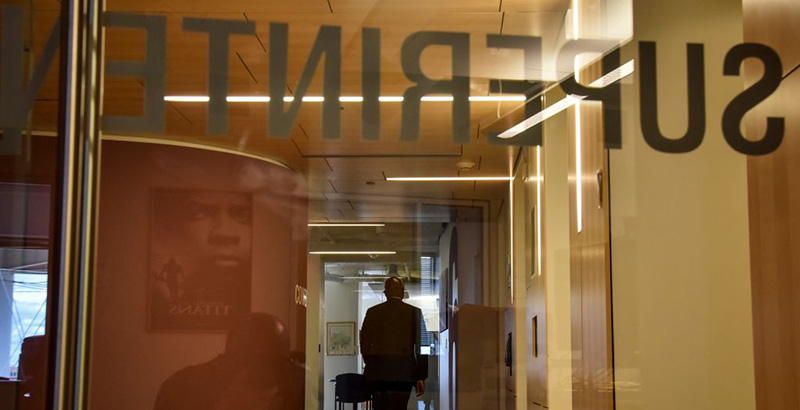Analysis: Gut-check Moment for School Superintendents — Toxic Politics, Demands for New Services, Struggles to Deliver Basics Make ‘Impossible Job’ Harder than Ever

Get stories like this delivered straight to your inbox. Sign up for The 74 Newsletter
Amid all the concern about staffing shortages in America’s schools, the continued strain is showing up in another key place: at the top.
Eight of the country’s 10 largest urban school districts have seen superintendent turnover since the coronavirus started disrupting public education in February 2020. Of the two that remain, one — Jesus Jara in Clark County, Nevada — was fired by his school board, only to be reinstated. The other, Barbara Jenkins of Orange County, Florida, recently announced her retirement. Big cities like Boston, Seattle and Philadelphia are also on the hunt for new school system leaders.
The American School District Panel is a nationally representative study of the nation’s school systems created by the Center on Reinventing Public Education, the RAND Corporation, Chiefs for Change and Kitamba. In a recent survey, just half of district chiefs said they plan to remain in their jobs long term. A quarter indicated they would soon head for the exits. If that number holds, the usual 13 percent annual turnover rate among top district leaders would roughly double.
Former Milwaukee Public Schools chief Howard Fuller once called the urban school district superintendency “the impossible job.” Two years into the pandemic, it may have gotten harder than ever. And the strain on district leadership may be a symptom of strain on the institutions they lead.
Disruptions spurred by the COVID-19 pandemic have made it harder for districts to deliver their core product. At the same time, the pandemic’s devastating effects on students have led to increased demands for districts to expand their missions, attending to student well-being and offering more supplemental learning. And they must navigate these competing pressures in an increasingly toxic political climate.
Districts are still struggling to deliver their core product: teaching, learning, open schools
For three school years in a row, school districts have failed to offer every student a full year’s worth of supervision and instruction. The 2019-20 academic year was cut short. It was followed by a year shifting in and out of remote instruction and, now, disruptions caused by quarantines and staff shortages.
Halfway through the current school year, there is some good news: Fewer and shorter quarantines could reduce one major source of learning disruption from this fall.
The number of districts requiring students to stay home for more than seven days after COVID exposure fell from 73 in September to 27 in January — a change fueled in part by the Centers for Disease Control and Prevention’s December guidance revising recommended quarantine periods to five days.
Logistical barriers keep most school districts from shifting seamlessly to online instruction when they have to close, and COVID-related absences have generally been treated like traditional ones this fall. Just 19 of the 100 districts in CRPE’s nationwide review of large and urban school systems commit to providing live, real-time instruction to students during quarantine, and 24 commit to providing check-ins with a teacher or staff member.
Even when students are not required to isolate or quarantine, staffing challenges make it harder than ever for districts to ensure every child is picked up at the bus stop and transported to a school building where they receive a day’s worth of instruction. We have found reports of staff-related disruptions or difficulty filling positions in 93 of the 100 districts in our review. Districts like Sacramento Unified report consistent problems finding substitute teachers.
Just how much school gets disrupted will vary depending on local conditions. In the most dramatic instance of COVID-related closures in our review, Detroit Public Schools kept campuses closed through Jan. 31.
The upshot is that, for the third academic year in a row, school districts are still offering most students and families less access to consistent instruction from a teacher of record than they would have in typical years. And shifting public health and logistical needs mean leaders’ attention remains diverted from the core work of planning to improve teaching and learning in the future.
Yet demands on districts are greater than ever
At the same time they’re struggling to deliver their core product effectively, school districts have shouldered deepening demands.
The pandemic reinforced districts’ role as go-to sources of critical social services. In the early days, they scrambled to offer digital devices, internet connections and meals. Now, growing numbers of districts are offering social and emotional learning, mental health support and supplemental instructional services like tutoring.
Demands on districts are rising with student needs. Parents and even the surgeon general and president have warned about a growing youth mental health crisis. And the pandemic’s harms to student learning demand urgent action.
But these emergency needs are layering on top of years of growing demands to expand the missions of school districts, at a time when they are struggling more mightily than ever to deliver their core product. Something has to give. The answer may be: Districts cannot be left to solve all the learning-related needs of children in their communities on their own.
During the pandemic, local organizations and municipal governments mobilized to support remote learning. They set up learning centers where students could get online. They offered tutoring, enrichment and fun activities for children and served as a critical safety net for many families.
The lesson should be a powerful one: There is strength in partnership. Districts that want to meet the demands of the moment have no choice but to work more closely with state and local governments, businesses, community organizations and volunteers who can help shoulder the work of ensuring all students recover.
Politics have turned toxic
As if the substantive and operational challenges facing school districts weren’t enough, they also face heightened political pressure, with a growing risk of taking an alarming turn. Districts face calls to ban books, new laws restricting what they can teach or discuss and standoffs with state officials over public health precautions.
In some cases, these disputes have led to threats that may play a role in some leaders’ departures. Guilford County, North Carolina, Superintendent Sharon Contreras issued a warning in her local newspaper this fall. Earlier this year, she announced she would be resigning.
“I am disappointed by the ongoing threats and violence against school board members, superintendents and educators who are simply trying to do the right thing by educating our children while keeping our schools and communities healthy,” she wrote. “Our staff has been bullied, and our buildings have been targeted by those who disagree with basic public health measures.”
Political turmoil only distracts leaders from other crises they are fighting to manage. The pandemic’s academic toll is worsening. Students have months’ worth of unfinished learning in reading and math, and those with the greatest disadvantages and who are hardest to teach remotely have experienced the greatest harm. Children who entered kindergarten during the pandemic are missing crucial building blocks of literacy and numeracy that they are struggling to replace.
Many districts face a flight of parents and students. Places like Oakland and Denver are eying new rounds of school closures, which places leaders in another bind: Either they shut schools, displacing already-traumatized students and inflaming public anger, or they keep schools open by subsidizing them with resources that could otherwise help districts keep their remaining schools well-staffed and equipped to reverse academic declines.
A gut-check moment for district leaders
The impossibility of district leadership reflects the reality that public education systems are subject to a set of demands that are impossible for them to meet — unless they discover new ways of operating.
This will require districts to find new ways to help educators partner directly with families to build trust. It will mean working with organizations in their communities — many of which may have reservoirs of trust with families — to join in helping to meet students’ needs. It will require districts to use their growing investments in online learning platforms to offer new, better and more diverse learning environments, potentially including pods and microschools, that rely on partnerships with families or community organizations. It will require state officials to give districts the freedom to innovate and enough political cover to keep angry parents at bay.
This is the moment when district leaders must look in the mirror, take measured risks to advance on a new course, form deeper partnerships with allies who can help fulfill their missions and win over adversaries.
While educators feel burnout, from the classroom to the superintendent’s office, there is still a way forward. There appears to be a silent majority of families who are weary from three pandemic-disrupted school years, appreciative of the hard work of teachers and administrators, and hungry for bold new approaches to educating children. The future of public education hinges on its ability to gain and keep their trust.
Bree Dusseault is principal at the Center on Reinventing Public Education, supporting its analysis of district and charter responses to COVID-19. She previously served as executive director of Green Dot Public Schools Washington, executive director of pK-12 schools for Seattle Public Schools, a researcher at CRPE, and as a principal and teacher. Travis Pillow is an innovation fellow and senior writer at the Center on Reinventing Public Education.
Get stories like these delivered straight to your inbox. Sign up for The 74 Newsletter

;)

